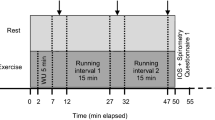Summary
Thirteen children each exercised for 6 min by running on a treadmill and by tethered swimming, breathing air at room temperature and either 8% or 99% relative humidity continuously. Ventilation, gas exchange and heart rate were closely matched in all four tests in each child, with a mean oxygen consumption of 32.3±1.7ml·min−1·kg−1. The post-exercise fall in FEV1 expressed as a percentage of the baseline FEV1 (δFEV1) was significantly greater after running compared with swimming breathing either humid or dry air. The δFEV1 was also related to respiratory heat loss (RHL) calculated from measurements of inspired and expired gas temperature and humidity. At a standardised RHL, the difference between running and swimming was highly significant [δFEV1 (%) ± SE=39±5 and 28±4 respectively, p<0.01]. These experiments suggest that the type of exercise influences the severity of exercise-induced asthma even under conditions of the same metabolic stress and respiratory heat loss.
Similar content being viewed by others
References
Anderson SD, Connolly N, Godfrey S (1971) Comparison of bronchoconstriction induced by cycling and running. Thorax 26: 396–401
Anderson SD (1972) Physiological aspects of exercise-induced bronchoconstriction. PhD Thesis, University of London
Anderson SD, Silverman M, Konig P, Godfrey S (1975) Exercise-induced asthma. Br J Dis Chest 69: 1–39
Bar-Or O, Neuman I, Dotan R (1977) Effects of dry and humid climates on exercise-induced asthma in children and adolescents. J Allergy Clin Immunol 60: 163–168
Chen WY, Horton DJ (1977) Heat and water loss from the airways and exercise-induced asthma. Respiration 34: 305–313
Deal Jr EC, McFadden Jr ER, Ingram Jr RH, Strauss RH, Jaeger JJ (1979a) Role of respiratory heat exchange in production of exercise-induced asthma. J Appl Physiol: Respirt Environ Exercise Physiol 46: 467–475
Deal Jr EC, McFadden Jr ER, Ingram Jr RH, Jaeger JJ (1979b) Hyperpnea and heat flux: Initial reaction sequence in exercise-indeced asthma. J Appl Physiol: Respirat Environ Exercise Physiol 46: 476–483
Deal Jr EC, McFadden Jr ER, Ingram Jr RH, Jaeger JJ (1979c) Esophageal temperature during exercise in asthmatic and nonasthmatic subjects. J Appl Physiol: Respirat Environ Exercise Physiol 46: 484–490
Eggleston PA, Guerrant JL (1976) A standardised method of evaluating exercise-induced asthma. J Allergy Clin Immunol 58: 414–425.
Fitch KS, Morton AR (1971) Specificity of exercise induced asthma. Br Med J 4: 577–581
Fitch KD, Godfrey S (1976) Asthma and athletic performance. JAMA 236: 152–157
Floyer, Sir John (1698) A treatise of asthma. Wilkin and Innis, London
Godfrey S (1974) Exercise testing in children: Application in health and disease. WB Saunders, London
Inbar O, Dotan R, Dlin RA, Neuman I, Bar-Or O (1980) Breathing dry or humid air and exercise-induced asthma while swimming. Eur J Appl Physiol 44: 43–50
James L, Faciane J, Sly RM (1976) Effects of treadmill exercise on asthmatic children. J Allergy Clin Immunol 57: 408–416
Jones RS, Buston MH, Wharton MJ (1962) The effect of exercise on ventilatory function in the child with asthma. Br J Dis Chest 56: 78–86
McArdle WD, Glaser RM, Magel JR (1971) Metabolic and cardio-respiratory response during free swimming and treadmill walking. J Appl Physiol 30: 733–738
Polgar C, Promadhat V (1971) Pulmonary function testing in Children. WB Saunders, Philadelphia, p 180
Shturman-Elstein R, Zeballos RJ, Buckley JM, Souhrada JF (1978) The beneficial effect of nasal breathing on exercise-induced broncho-constriction. Am Rev Respir Dis 118: 65–73
Silverman M, Anderson SD (1972) Standardization of exercise tests in asthmatic children. Arch Dis Childh 47: 882–889
Weinstein RE, Anderson JA, Kvale P, Sweet LC (1976) Effects of humidification on exercise-induced asthma (EIA). J Allergy Clin Immunol 57: 250–251
Author information
Authors and Affiliations
Consortia
Rights and permissions
About this article
Cite this article
Bar-Yishay, E., Gur, I., Inbar, O. et al. Differences between swimming and running as stimuli for exercise-induced asthma. Europ. J. Appl. Physiol. 48, 387–397 (1982). https://doi.org/10.1007/BF00430229
Accepted:
Issue Date:
DOI: https://doi.org/10.1007/BF00430229




